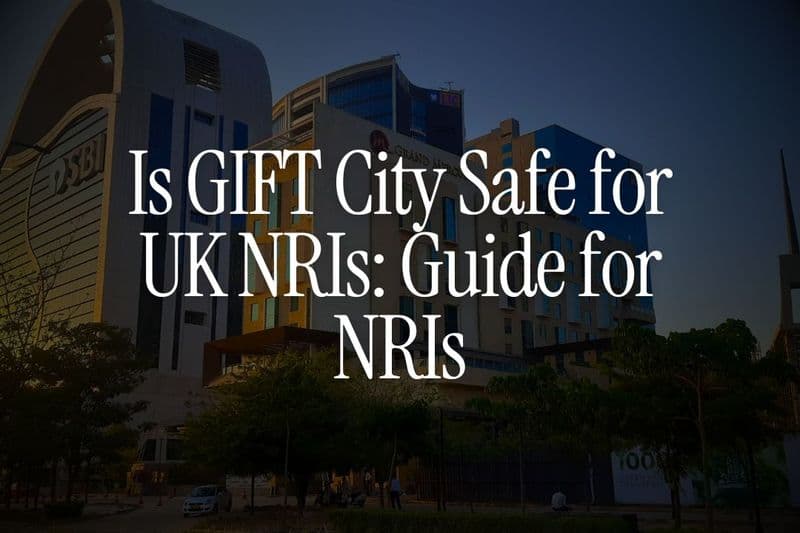
Amit, a software engineer in Dubai, just closed a ₹50 lakh NRE FD at 7% interest. His friend Priya invested the same amount in debt mutual funds. Seven years later, Priya's portfolio is worth ₹82 lakhs. Amit's FD matured at ₹72 lakhs.
What happened?
If you're an NRI staring at two WhatsApp forwards - one promising "tax-free 7.25% FD returns" and another claiming "10% mutual fund growth" - you're not alone. At Belong, we've had thousands of conversations with NRIs in the UAE through our WhatsApp community who ask this exact question.
This isn't just about interest rates. It's about after-tax returns, currency risk, liquidity, and where your money actually ends up after 5-10 years.
By the end of this article, you'll know exactly which option suits your financial goals - or whether you should use both. We'll skip the sales pitch and give you the math, the regulations, and the real-world scenarios.
Why This Question Keeps NRIs Up at Night
Here's what makes this decision tough for NRIs:
You earn in dollars or dirhams but want to invest in India. FDs promise safety and tax-free returns. Mutual funds promise higher growth but come with market risk. And then there's tax treatment in your country of residence, repatriation rules, and the rupee's never-ending depreciation.
The stakes are high. Choose wrong, and inflation silently eats your returns. Choose right, and you could grow your wealth 30-40% more over a decade.
Let's break it down.
What Are NRI Fixed Deposits? (The Four Types You Need to Know)
An NRI fixed deposit is where you park money for a fixed tenure and earn guaranteed interest. But there are four distinct types:
1. NRE Fixed Deposits (Non-Resident External)
You convert your foreign earnings to INR and deposit. Both principal and interest are fully repatriable and tax-free in India.
Current rates: 6.40% to 7.50% p.a. depending on bank and tenure (as of November 2025, source: ICICI Bank, HDFC Bank).
Best for: NRIs who want to eventually bring money back to their home country.
Also Read -Best NRI Fixed Deposit Accounts India Complete Tax & Rate Guide
2. NRO Fixed Deposits (Non-Resident Ordinary)
For money you already have in India - rental income, pension, inheritance. Interest is taxable at 30% TDS. Repatriation limited to $1 million per financial year.
Current rates: Similar to NRE, but post-tax returns are much lower.
Best for: Managing India-sourced income.
3. FCNR Fixed Deposits (Foreign Currency Non-Resident)
You keep money in the foreign currency itself (USD, GBP, EUR, etc.). No currency risk. Interest is tax-free. Fully repatriable.
Current rates: 3.5% to 4.5% p.a. in USD terms.
Best for: NRIs who want zero currency risk.
Also Read -NRE vs NRO vs FCNR
4. GIFT City USD Fixed Deposits
The newest option. You deposit in USD, earn 4-5% p.a., and pay zero tax in India. Fully repatriable. Regulated by IFSCA.
Best for: UAE-based NRIs who want to avoid INR exposure entirely.
Learn more: GIFT City FD vs NRE/NRO/FCNR FDs
👉 Tip: If you're planning to return to India eventually, NRE FDs make sense. If you're settling abroad permanently, consider FCNR or GIFT City USD FDs.
What Are Mutual Funds for NRIs?
Mutual funds pool money from investors and invest in stocks (equity funds) or bonds (debt funds). Returns are market-linked - not guaranteed.
For this comparison, we're focusing on debt mutual funds since they're closer to FDs in risk profile.
Debt mutual funds invest in corporate bonds, government securities, and money market instruments. They aim for 7-10% returns with moderate risk.
Current average returns: 7-10% p.a. over 5-7 years (source: Groww, INDmoney).
Can NRIs Invest in Mutual Funds?
Yes, but with conditions:
Allowed: NRIs can invest in Indian mutual funds online through KYC-compliant AMCs. Returns are repatriable.
Not allowed for:
- US residents (complicated due to PFIC rules - Passive Foreign Investment Company taxation)
- Residents of Canada (restricted by some AMCs)
Tax treatment for Debt Mutual Funds: Both Short-term capital gains (held \< 2 years) and Long-term capital gains (held > 2 years) taxed at slab rates up to 30%s (post-April 2023).
Learn more: Taxation of Mutual Funds for NRI in India
The 7-Year Reality Check: Actual Returns Comparison
Let's take ₹10 lakhs invested in January 2018 and redeemed in January 2025.
Scenario 1: NRE Fixed Deposit at 7% p.a.
- Principal: ₹10,00,000
- Interest rate: 7% p.a. compounded annually
- Maturity after 7 years: ₹16,05,781
- Tax in India: Zero
- Tax abroad (UAE): Zero (UAE has no income tax)
- Final amount: ₹16,05,781
Scenario 2: Debt Mutual Fund at 7.5% p.a. (average)
Pre April 2023
- Initial investment: ₹10,00,000
- Average return: 7.5% p.a. (conservative estimate for good debt funds)
- Value after 7 years: ₹17,10,000
- LTCG tax (20% with indexation for pre-2023): ~₹95,000 (after indexation reduces taxable gain to ~₹4.75 lakhs).
- Final amount: ₹16,15,000.
- Final amount for new investments post-2023: ~₹14,00,000
( Tax at slab rate, e.g., 30% on full gain if high slab)
Winner Debt Mutual funds!
Post April 2023 investment
- Initial investment: ₹10,00,000
- Average return: 7.5% p.a. (conservative estimate for good debt funds 2018–2025)
- Value after 7 years: ₹17,10,339
- Capital gains: ₹7,10,339
LTCG tax (30% slab rate, no indexation): ₹2,13,102 - Final amount: ₹14,97,237
- Winner: NRE FD by ₹1,08,544** (7.2% more).
But wait - this doesn't account for currency depreciation.
The Currency Risk Factor: The ₹10 Lakh Experiment
Here's where it gets interesting for NRIs.
Assume INR depreciated 3% annually against the dollar (which it has historically). After 7 years:
NRE FD Scenario
You earn interest on ₹10 lakhs. But when you convert maturity proceeds to dollars, only the interest component gets the benefit of higher INR (more rupees per dollar).
In dollar terms: The effective return drops to about 4-4.5% p.a. after accounting for depreciation on the principal.
Debt Mutual Fund Scenario
Your capital gains calculation happens in dollars (if you're converting back). Both principal and gains benefit from rupee depreciation.
Result: Debt funds give you a higher effective return in dollar terms because the entire corpus - not just the interest - benefits from rupee weakness.
This is exactly what happened to Amit and Priya at the beginning of this article. Experts confirm that for NRIs who will eventually convert to foreign currency, debt mutual funds can deliver 15-20% better real returns over the long term.
👉 Tip: Use our Rupee vs Dollar Tracker to see how INR depreciation affects your investments.
Where Your Money Actually Goes: The Tax Maze
This is where FDs and mutual funds diverge sharply.
NRE FD Taxation
In India: Zero tax on interest.
Abroad: Depends on your country of residence.
- UAE, Saudi, Qatar: Zero tax (no income tax)
- US, UK, Canada: Interest is taxable as ordinary income in your country. You'll pay 20-35% tax depending on your slab.
- DTAA benefit: You can claim Double Taxation Avoidance Agreement credits to avoid being taxed twice.
For US residents, NRE FD interest is taxed every year even if you don't withdraw. This significantly reduces the effective return.
Read more: DTAA India USA
Debt Mutual Fund Taxation
In India:
Debt mutual funds are taxed taxed at slab rates upto 30% irrespective of holding periods for investments post April 2023
Abroad:
- UAE: Zero tax
- US: Complicated (PFIC rules apply - mutual funds become very tax-inefficient)
- UK, Singapore, Australia: Taxed on redemption as capital gains
The key difference: In mutual funds, you pay tax only when you redeem (except for US residents). In FDs, interest is taxed annually.
Learn more: NRI Taxation Guide | FD Taxation for NRIs
Also Read - Taxation on Mutual Funds
Liquidity: When You Need Money Back Fast
Fixed Deposits
Premature withdrawal penalty: Most banks charge 0.5-1% penalty on the contracted rate. If you break an NRE FD before 1 year, you get zero interest.
Loan against FD: You can take an overdraft up to 90% of FD value at interest = FD rate + 1-2%. This preserves your FD while giving you liquidity.
Verdict: Moderate liquidity. Breaking FDs early is expensive.
Debt Mutual Funds
Exit load: Most funds charge 0.25-1% if redeemed within 3-6 months. After that, zero exit load.
Redemption time: Money hits your account in 1-3 business days.
Partial redemption: You can withdraw any amount without touching the rest.
Verdict: High liquidity. Debt funds are far more flexible.
👉 Tip: Keep 6 months' expenses in liquid funds or GIFT City FDs for emergency access without penalty.
Risk Profile: Can You Sleep at Night?
Fixed Deposits
Risk level: Very low. Your principal is guaranteed up to ₹5 lakhs per bank by DICGC insurance.
Safety: Regulated by RBI. Major banks (HDFC, ICICI, SBI, Axis) are extremely safe.
Returns: Fixed. You know exactly what you'll get.
Best for: Risk-averse investors, retirees, emergency funds.
Debt Mutual Funds
Risk level: Low to moderate. Not risk-free.
Risks:
- Interest rate risk: When RBI raises rates, bond prices fall, NAV drops temporarily
- Credit risk: If a company whose bond the fund holds defaults, NAV can fall 5-10%
- Liquidity risk: In extreme market stress, some funds may take longer to process redemptions
Historical volatility: Debt funds can give negative returns in a bad year (e.g., during 2013 taper tantrum, some debt funds fell 3-5%).
Best for: Investors comfortable with 5-10% short-term NAV fluctuations for better long-term returns.
Learn more: Best Investment Options for NRIs
Repatriation Rules: Getting Your Money Out of India
NRE Fixed Deposits
Principal + Interest: Fully repatriable without limits. No RBI approval needed. No tax documentation required.
NRO Fixed Deposits
Limit: Up to $1 million per financial year. Requires Form 15CA/15CB and tax clearance certificate.
Also Read -How to Repatriate Funds from NRO/NRE Accounts
Mutual Funds (Debt)
Repatriation: Fully allowed. Need to show tax paid on capital gains (TDS certificate).
Process: Most AMCs allow direct credit to NRE account. From there, you can remit abroad.
Learn more: Ways to Avoid NRI Tax Payment Penalties
Which One for Your Goal?
Your choice depends on your financial goal and risk appetite.
Choose Fixed Deposits If:
You need guaranteed returns (retirement corpus, child's education fund)
You're risk-averse and can't stomach NAV fluctuations
You want zero hassle and don't want to monitor markets
Your investment horizon is 1-3 years (short-term goals)
You're planning to return to India and want INR exposure
Best banks: HDFC, ICICI, Axis, SBI
Check latest rates: Best NRI Fixed Deposit Rates
Choose Mutual Funds If:
You want higher returns and can accept moderate risk
Your investment horizon is 5+ years
You want tax efficiency (indexation benefit on LTCG)
You want better protection against rupee depreciation
You need liquidity - ability to withdraw anytime without penalty
You're not a US resident (PFIC rules make mutual funds tax-inefficient for US NRIs)
Best funds: HDFC Short Duration Fund, ICICI Prudential Corporate Bond Fund, Aditya Birla Sun Life Medium Term Plan (always check 3-5 year returns before investing)
Learn more: How NRIs Can Invest in Mutual Funds in India
The Hybrid Strategy (What We Recommend at Belong)
Here's what most financially savvy NRIs do - and what we help clients implement:
The 50-30-20 Split
50% in NRE/GIFT City FDs: For safety, guaranteed returns, and peace of mind. Split across 3-4 banks for DICGC insurance coverage.
30% in Debt Mutual Funds: For better inflation-adjusted returns and liquidity. Spread across 2-3 funds (short duration, corporate bond, banking & PSU).
20% in Equity Mutual Funds or AIFs: For long-term wealth creation (only if you have 7+ year horizon). Equity historically beats inflation by 5-7% annually.
Example: ₹1 crore corpus
- ₹50 lakhs: Split as ₹25L in HDFC NRE FD, ₹25L in GIFT City USD FD
- ₹30 lakhs: ₹15L in HDFC Short Duration Fund, ₹15L in ICICI Corporate Bond Fund
- ₹20 lakhs: ₹10L in Nifty 50 Index Fund, ₹10L in GIFT City AIF
This strategy gives you safety, liquidity, and growth.
👉 Tip: Rebalance annually. If equity zooms to 30%, book profits and move to FDs. If FDs mature, check if mutual funds are down - that's your buying opportunity.
Check our: Best NRI Investment Platforms
Why GIFT City USD Fixed Deposits Change Everything
If you're based in UAE, Saudi, Qatar, or anywhere with a USD-pegged currency, GIFT City FDs are a game-changer.
Why?
- Zero currency risk: Your dollars stay dollars. No INR conversion.
- Zero tax in India: Interest is tax-exempt under IFSC rules.
- Zero tax in UAE: No income tax in GCC countries.
- Higher than global rates: 4-5% p.a. in USD beats 0.1% in UAE banks or 1-2% in US savings accounts.
- Fully repatriable: No limits, no paperwork.
- Regulated: By IFSCA, not RBI, but equally safe.
Returns comparison for UAE NRIs:
Product | Rate | Currency Risk | Tax | Repatriation |
|---|---|---|---|---|
UAE Bank FD | 0.5-1% | None | None | Full |
NRE FD | 6.5-7.5% | High (INR) | None (India) | Full |
GIFT City USD FD | 4.5-6% | None | None | Full |
Debt Mutual Fund | 8-10% | High (INR) | Upto 30% Slab rate | Full |
For UAE-based NRIs, GIFT City FDs give the best risk-adjusted returns without currency or tax complications.
Belong offers GIFT City FDs starting at $1,000. No hidden fees. 100% digital KYC. Download the app to get started.
Learn more: GIFT City Benefits for NRIs | Belong NRI Investment in GIFT City
How Belong Helps NRIs Navigate These Choices
At Belong, we've built tools and a community to help NRIs make smarter financial decisions:
1. NRI FD Rates Explorer
Compare NRE, NRO, FCNR, and GIFT City FD rates across 25+ banks in real-time. See which bank offers the highest rate for your tenure.
2. Residential Status Calculator
Not sure if you're NRI, RNOR, or Resident? Use our calculator to find out. Your status affects how you're taxed.
3. WhatsApp Community
Join 5,000+ NRIs in the UAE sharing experiences, asking tax questions, and discussing investment strategies. Join here.
4. GIFT City USD FDs
We've partnered with GIFT City banks to offer USD fixed deposits directly through the Belong app. No currency risk. No tax. Start with $500. Explore here.
5. Compliance Compass
Check if you're following all Indian regulations across banking, investments, and taxation. Try it.
Final Verdict: FDs or Mutual Funds?
There's no one-size-fits-all answer. Your choice depends on:
Risk appetite: Low risk → FDs. Moderate risk → Debt funds.
Investment horizon: Short-term (1-3 years) → FDs. Long-term (5+ years) → Mutual funds.
Country of residence: UAE/GCC → NRE FDs or GIFT City FDs. US → Avoid mutual funds (PFIC rules).
Currency preference: Want dollars → GIFT City USD FDs or FCNR. Okay with INR → NRE FDs or debt funds.
Tax efficiency: Debt mutual funds have indexation benefit on LTCG. FDs are simpler but no indexation.
Our recommendation: Use both. Allocate 50-70% to FDs for stability and 30-50% to debt mutual funds for growth. If you're in the UAE, seriously consider GIFT City USD FDs - they eliminate currency risk and tax while giving 4.5-6% returns.
The best investment is one that lets you sleep at night while still beating inflation. Don't chase the highest return if it keeps you anxious.
Take the Next Step
Ready to make a decision?
Compare FD rates across banks: NRI FD Rates Tool
Open a GIFT City USD FD in 10 minutes: Download Belong App
Join 5,000+ NRIs discussing investments: WhatsApp Community
Check your residential status: Free Calculator
At Belong, we help NRIs invest smarter - no jargon, no hidden fees, just honest advice and better tools. Whether you choose FDs, mutual funds, or both, we're here to guide you.
Your financial future deserves better than WhatsApp forwards.
Disclaimer: This article is for educational purposes and should not be considered personalized investment advice. Investment decisions should be made after considering your financial goals, risk appetite, and tax situation. Consult a SEBI-registered investment advisor before investing. Mutual fund investments are subject to market risks. Read all scheme-related documents carefully.
Sources:




